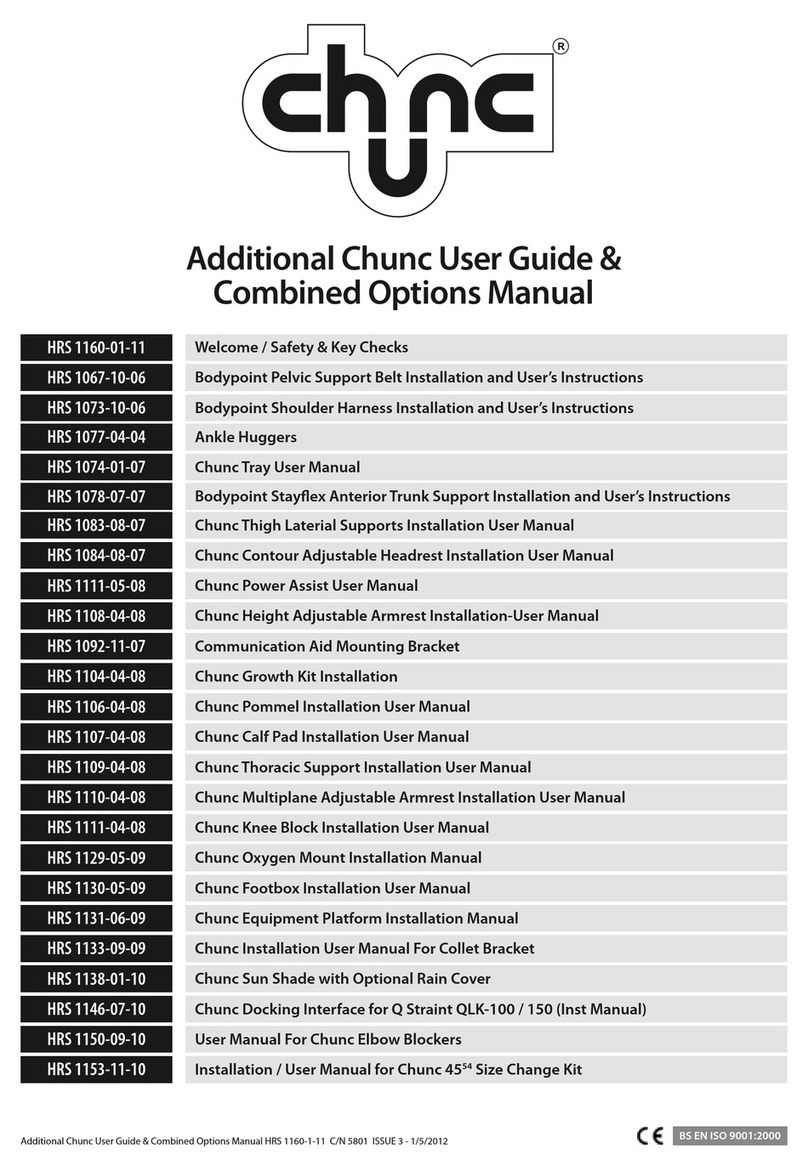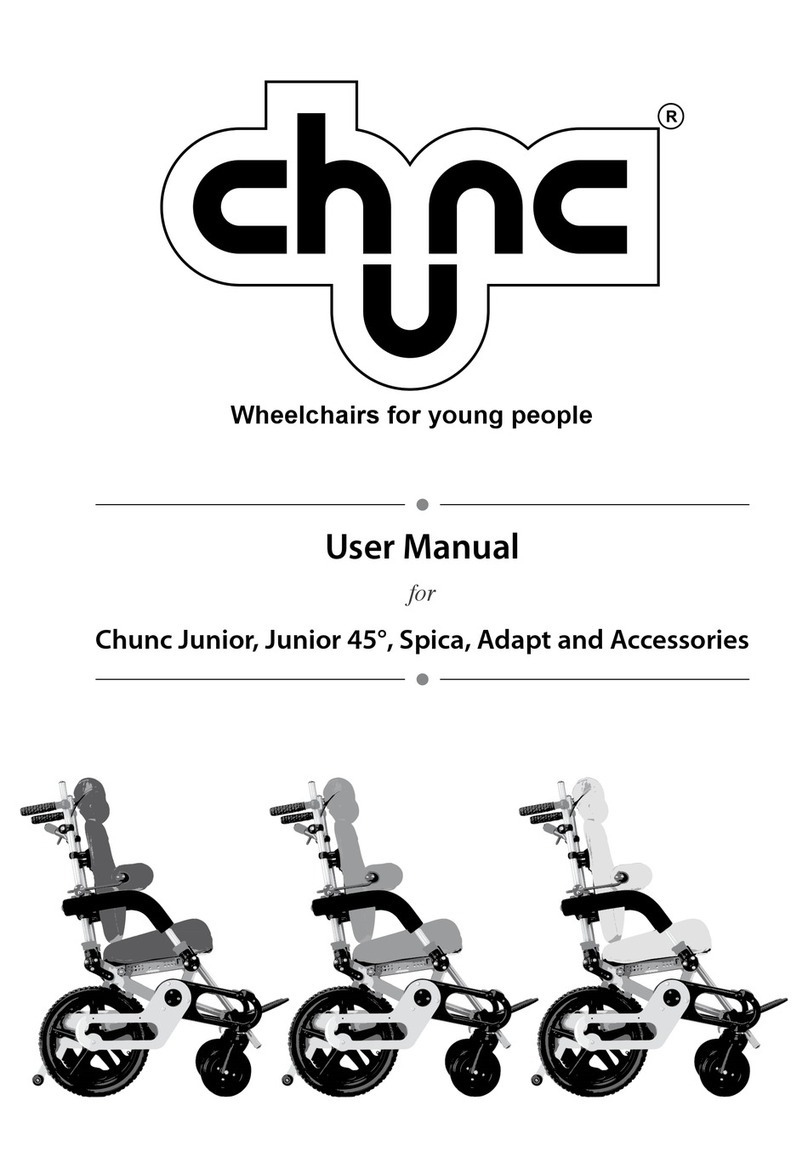Chunc One User manual

< wheelchair user manual
R

< before use
>Before transferring the user, an inspection should be made of the product, ensuring all required
parts are secured and in good working order.
>Special attention should be paid to the grey hand tightened components and particularly the
backrest collet caps and the caution label at the base of the backrest.
>Ensure the wheelchair rolls freely, without excessive noise or vibration; if you are uncertain of
the wheelchair’s performance, it should not be used and your Chunc representative should be
contacted as soon as possible.
< Intended use including transportation
The Chunc One is a manual attendant controlled wheelchair. The Chunc Adapt is a manual attendant
controlled wheel base for use with a surrogate seating system. A range of accessories is available which
are intended to provide additional mobility, postural management and adjustable seating solutions.
All Chunc One wheelchairs are intended for a single occupant with moderate to specialist needs
such as cerebral palsy and whose mass does not exceed 110kg /242b. The maximum load capacity
(including an occupant up to 110kg) and any auxiliary equipment (such as communication and
respiratory aids) and, if applicable, surrogate seating for the Adapt, should not exceed 110kg/242lb.
The wheelchairs are designed for indoor and outdoor use; however they are not intended for use on
rough terrain.
All Chunc wheelchairs are suitable for use as a forward facing seat in a motor vehicle when used in
conjunction with 4 point tie down restraints (WTORS); see section “Safe Transportation in a motor
vehicle” or QLK type.
< getting started
!
It is recommended you do not remove your
Chunc wheelchair from the box or assemble
it without a Chunc representative, your
distributor/dealer or a trained healthcare
professional in attendance.
Take care when unpacking your Chunc
wheelchair and ask somebody to assist you
with the heavier parts.
Check all ordered parts are present, in
working order and are free from damage. In
the inlikely event you find a fault, contact your
supplier immediately.
page 1
R

< postural management
Chunc wheelchairs are Class 1 medical devices and must not be used to seat any
person without prior consultation of a qualified health care professional. A qualified
health care professional should be present when fitting or adjusting the Chunc
wheelchair and accessories to an occupant.
The occupant’s seating posture and the positioning of adjustable parts and accessories
should be monitored closely and adjusted as directed by a healthcare professional
in accordance with the instructions in this manual. Ensure harnesses are fitted to the
manufacturer’s instructions and their adjustment monitored closely. Any adjustments
should be as directed by a health care professional and inaccordance with the
manufacturer’s instructions.
Failure to comply with these washing instructions may result in the reduction of
performance of your product. Over a prolonged period this could constitute a safety
hazard.
< lifting
A minimum of two people should only attempt this operation. Ensure the handle grips
are as high as possible and tightened, resting against the fixed end caps. If the Chair
and occupant need to be lifted, lift using the front tie down points and the rear handle
grips.Do not lift the wheelchair with the footrests.
< stability
Consider the stability of the wheelchair and occupant at all times, especially when on
slopes and uneven ground. Movement of the user and the occupant’s body position
can affect stability. Keep the user in a seated position whenever possible, with their
back firmly against the backrest.
Do not place bags or any other unauthorised equipment on the framework. Ensure the
anti-tip levers are engaged at all times where practical. When placing an occupant in a
fully reclined position consider their body position’s affect on stability.
< important information
< for your safety
At Chunc, safety is paramount in the product’s design, development and manufacture.
Misuse and adverse environments can lead to potentially hazardous situations that
could result in injury or even death. It is therefore essential this manual is read prior to
performing maintenance on a Chunc wheelbase/wheelchair and kept for reference. At
Chunc we also believe in continuous improvement. If you have any questions or com-
ments about our customer service, product literature or products we would be pleased
to receive them. This manual can be downloaded from www.chunc.com
Chunc wheelchairs and accessories are of modular design and can be maintained
using basic tooling as detailed in section ‘Tools’. If a fault has been identified and is
beyond repair by adjusting the fitting, the part or parts must be replaced to maintain
the product warranty.The fitting or modification of any Chunc component, whether
repair, adjustment or maintenance must be carried out by Chunc approved engineers,
health care professionals or appointed NHS repairers. Failure to comply with these in-
structions may invalidate the warranty and endanger the occupant and attendant. If at
any time you suspect a fault or any of the equipment is damaged or behaves erratically
or you are uncertain of the wheelchair’s performance it should not be used until it has
been checked by your Chunc Representative or appointed NHS repairer.
< maintenance
Your Chunc product requires periodic maintenance in order for it to function
correctly and safely. Before transferring the user, an inspection should be made of
the wheelchair, ensuring all required parts are fixed securely in position, and in good
working order.
< occupant safety
Never leave an occupied Chunc wheelchair unattended. Never exceed the wheelchair’s
occupant weight limit, or maximum load capacity, or use for any purpose outside the
manufacturers instructions
page 2
R

< finger traps
Be careful when operating the wheelchair, remaining aware of finger traps around
moving parts, when removing and replacing parts or making adjustments. Take extra
care when operating the grey locking collet cap of the backrest and armrests. Observe
the potential finger trap for both the occupant and operator between the rear wheel
and chassis plates. It is possible to purchase a wheel guard from your supplier.
< cleaning
All Chunc upholstered parts must be cleaned following the care label stitched
into the cover. They can be cleaned using water and commercially available fabric
washing detergents and non-toxic soap (neutral soap). The padding inside the
upholstery should not be cleaned with any liquid; only lightly brush to refresh the
surface. Always ensure all mating Velcro parts are pressed together prior to washing.
Exposed hooked Velcro can cause damage to items in a wash cycle.
The armrests are covered with closed cell foam. They can be wiped clean using
a damp cloth. We do not recommend the use of detergents on these parts.
The wheelchair frame is constructed from high quality engineering materials including
powder-coated steel, nylon composite moldings and stainless steel fasteners.It can be
cleaned using water and commercially available household detergentsand non-toxic
soap (neutral soap). Before cleaning the wheelchair, all upholstery, including the
armrests should be removed. It may be necessary to use a brush or cloth to remove
embedded dirt or remove deposits from sheltered areas. Do not pressure wash.
< extended life re-use / recycling / disposal
Your product is designed and manufactured with high quality materials and
components, which can be recycled and reused. When the wheelchair’s life can
be prolonged no further, it can be easily dismantled into its respective material
groups. Approximately 90% of the wheel-chair by weight is recyclable. Consider
the environment when disposing of your old product. Ensure it is recycled where
applicable by giving it to a recycling organisation at the end of its life.
< safety warranty
< product warranty and disclaimer
UK, Europe, Rest of World (excluding USA)
The warranty period is 24 months, with the exception of foams, covers and Chunc
modifications which are warranted for 12 months from the date of delivery from the
manufacturer.
Any defect found within the warranty period will be corrected without charge by the
manufacturer. However, the warranty is dependent on the product having been used,
handled, stored, maintained, installed and operated in accordance with sound practice,
including any instructions issued by the manufacturer. Any misuse or unauthorized
alterations will invalidate this warranty.
The manufacture is not responsible for any modifications made by any third party. Any
individual who is to operate or maintain this wheelchair must have read the user and
maintenance manual in its entirety. In the event of any breach of the Manufacturer’s
warranty (whether by reason of defective materials, production faults or otherwise) the
Manufacturer’s liability shall be limited to the replacement of the Products in question
or at the Manufacturer’s discretion, repayment of the purchase price (where this has
been paid).
The Chunc range of products are designed and manufactured to meet the
requirements of the Medical Devices Directive 93/42/EEC for Class 1 medical devices.
Specmat Limited holds the British Standard Quality Approval to BS EN ISO 9001:2000
for the design and manufacture of medical devices.
Patents pending include EP 03251925, Design Registration includes USD 475952, EC
000080627. Granted Patent U.S. 6,994,364
Chunc is a trademark of Specmat Ltd, part of the HR Smith Group of Companies.
© Copyright Specmat Ltd 2015
All rights reserved. All technical information is subject to alteration without notice.
page 3
R

< 1. wheel locks
They are designed to prevent a stationary wheelchair from rolling and should NEVER be used as brakes to slow a
moving chair. The wheel locks can be foot engaged, by lifting the levers (C) to a stop. The locks are disengaged by
pressing down on the levers (C) until they hit a stop.
Safety note: Before disengaging the wheel locks, ensure the wheelchair is under control. Always
apply wheel locks when the chair is stationary. The wheel locks are less effective on worn tyres.
< 2. tip assist
The wheelchair can be tipped onto just its rear wheels, allowing it to traverse steps and curbs. To
perform this, press down on the wheel lock lever (C). Using the handlebars, rotate the wheelchair
about the rear wheel to lift the castors. Ensure you have full control of your chair when you perform this operation.
< 3. anti tip levers
These are designed to reduce the possibility of a tip. To increase wheelchair stability, move the anti-tip levers (B) to
their rearmost position. To disengage, push the levers (B) to their foremost position. Both anti-tip levers should be
used together to avoid potential instability.
< 4. tilt in space
The angle of the chair can be adjusted by compressing the tilt lever (A) and using the
handlebars to adjust the seat’s angle. It is advised that the wheel locks are engaged during this operation. The
wheelchair may be less stable when tilted.
< 5. swing away footrests
To swing under, pull the lower handle of the grey snap clip towards the front of the chair. The
bar it grips will be released, and the foot rests can swing away under the chair. To re-secure, bring
the footrest’s central bar to the clip, and push together firmly until they click into place. Beware of the potential
finger trap between the snap clip and the leg rest down tubes.
< everyday use
A
B
C
page 4
R
Table of contents
Other Chunc Wheelchair manuals



















